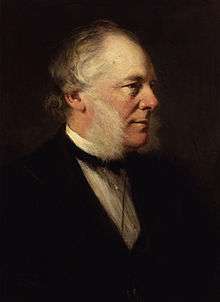Self-Help (book)
Self-Help; with Illustrations of Character and Conduct was a book published in 1859 by Samuel Smiles. The second edition of 1866 added Perseverance to the subtitle. It has been called "the bible of mid-Victorian liberalism".[1]
 Samuel Smiles by Sir George Reid | |
| Author | Samuel Smiles |
|---|---|
| Country | United Kingdom |
| Language | English |
| Publisher | John Murray |
Publication date | 1859 |
| Preceded by | The Life of George Stephenson |
| Followed by | Brief Biographies |
Contents of the second edition
- Preface
- Introduction to the First Edition
- Descriptive Contents
- Self-Help—National and Individual
- Leaders of Industry—Inventors and Producers
- Three Great Potters—Palissy, Böttgher, Wedgwood
- Application and Perseverance
- Helps and Opportunities—Scientific Pursuit
- Workers in Art
- Industry and the Peerage
- Energy and Courage
- Men of Business
- Money—Its Use and Abuse
- Self-Culture—Facilities and Difficulties
- Example—Models
- Character—the True Gentleman
Reception
Self-Help sold 20,000 copies within one year of its publication. By the time of Smiles' death in 1904 it had sold over a quarter of a million.[2] Self-Help "elevated [Smiles] to celebrity status: almost overnight, he became a leading pundit and much-consulted guru".[3] The book was translated and published in Dutch, French, Danish, German, Italian, Japanese, Arabic, Turkish, and in several Indian languages.[4]
When an English visitor to the Khedive's palace in Egypt asked where the mottoes on the palace's walls originated, he was given the reply: "They are principally from Smeelis, you ought to know Smeelis! They are from his Self-Help; they are much better than the texts from the Koran!"[5]
The socialist Robert Tressell, in his novel The Ragged Trousered Philanthropists, said Self-Help was a book "suitable for perusal by persons suffering from almost complete obliteration of the mental faculties".[6]
The founder of Toyota Industries Co., Ltd., Sakichi Toyoda was significantly influenced by his reading of Self-Help. A copy of Self-Help is under a glass display at the museum that exists on Sakichi Toyoda's birth site.[7]
Robert Blatchford, a socialist activist, said it was "one of the most delightful and invigorating books it has been my happy fortune to meet with" and argued it should be taught in schools. However he also noted that socialists would not feel comfortable with Smiles' individualism but also noted that Smiles denounced "the worship of power, wealth, success, and keeping up appearances".[8] A labour leader advised Blatchford to stay away from it: "It's a brutal book; it ought to be burnt by the common hangman. Smiles was the arch-Philistine, and his book the apotheosis of respectability, gigmanity, and selfish grab".[9] However Jonathan Rose has argued that most pre-1914 labour leaders who commented on Self-Help praised it and it was not until after the Great War that criticisms of Smiles in worker's memoirs appeared.[10] The Labour Party MPs William Johnson and Thomas Summerbell admired Smiles' work and the Communist miners leader A. J. Cook "started out with Self-Help".[11]
Notes
- M. J. Cohen and John Major (eds.), History in Quotations (London: Cassell, 2004), p. 611.
- Peter W. Sinnema, 'Introduction', in Samuel Smiles, Self-Help (Oxford: Oxford University Press, 2002), p. vii.
- Sinnema, p. vii.
- Briggs, Asa (2015). "Chapter 5 : Samuel Smiles and the Gospel of Work". Victorian People: A Reassessment of Persons and Themes, 1851-67. University of Chicago Press. p. 118. ISBN 978-0-226-21947-9 – via DE GRUYTER.

- Sinnema, p. xxiv.
- Robert Tressell, The Ragged Trousered Philanthropists (Penguin, 2004), pp. 572–73.
- Jeffrey K Liker, The Toyota Way (McGraw Hill, 2004), pp. 17.
- Jonathan Rose, The Intellectual Life of the British Working Classes (Yale Nota Bene, 2002), pp. 68–9.
- Rose, p. 68.
- Rose, pp. 68–9.
- Rose, p. 69.
Further reading
- Samuel Smiles, Original Text Self Help at Project Gutenberg
- Asa Briggs, 'Samuel Smiles and the Gospel of Work', Victorian People (Chicago: Chicago University Press, 1955).
- Asa Briggs, 'A Centenary Introduction' to Self-Help by Samuel Smiles (London: John Murray, 1958).
- Tom Butler-Bowdon, Self-Help by Samuel Smiles, in 50 Self-Help Classics: 50 Inspirational Books to Transform Your Life (London: Nicholas Brealey, 2003).
- Christopher Clausen, 'How to Join the Middle Classes with the Help of Dr. Smiles and Mrs. Beeton', American Scholar, 62 (1993), pp. 403–18.
- Kenneth Fielden, 'Samuel Smiles and Self-Help', Victorian Studies, 12(1968), pp. 155–76.
- Lord Harris of High Cross, 'Foreword', Self-Help (Civitas: Institute for the Study of Civil Society, 1996).
- Sir Eric Hobsbawm, The Age of Capital: 1848–1875 (London: Weidenfeld and Nicolson,1975).
- Sir Keith Joseph, 'Foreword', Self-Help (Sidgwick & Jackson, 1986).
- R. J. Morris, 'Samuel Smiles and the Genesis of Self-Help ', Historical Journal, 24 (1981), pp. 89–109.
- Jeffrey Richards, 'Spreading the Gospel of Self-Help: G. A. Henty and Samuel Smiles', Journal of Popular Culture, 16 (1982), pp. 52–65.
- Tim Travers, 'Samuel Smiles and the Origins of "Self-Help": Reform and the New Enlightenment', Albion, 9 (1977), pp. 161–87.